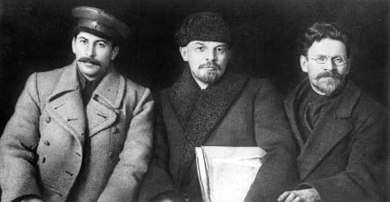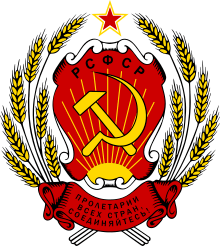Mikhail Kalinin
| Mikhail Kalinin | |
|---|---|
.jpg) Mikhail Kalinin in 1920 | |
| Chairman of the Presidium of the Supreme Soviet of the Soviet Union | |
|
In office 17 January 1938 – 19 March 1946 | |
| Deputy | Nikolay Shvernik |
| Preceded by | None—post established |
| Succeeded by | Nikolay Shvernik |
| Chairman of the Central Executive Committee of the All-Russian Congress of Soviets | |
|
In office 30 March 1919 – 15 July 1938 | |
| Preceded by | Mikhail Vladimirsky (acting) |
| Succeeded by | Aleksei Badayev |
| Full member of the 15th, 16th, 17th, 18th Politburo | |
|
In office 1 January 1926 – 3 June 1946 | |
| Member of the Orgburo | |
|
In office 16 March 1921 – 2 June 1924 | |
| Candidate member of the 8th, 9th, 10th, 11th, 12th, 13th, 14th Politburo | |
|
In office 25 March 1919 – 1 January 1926 | |
| Personal details | |
| Born |
Mikhail Ivanovich Kalinin 19 November 1875 Verkhnyaya Troitsa, Tver Governorate, Russian Empire |
| Died |
3 June 1946 (aged 70) Moscow, Russian SFSR, Soviet Union |
| Nationality | Soviet |
| Political party | Communist Party of the Soviet Union |
| Spouse(s) | Ekaterina Ivanovna Lorberg-Kalinina |
| Occupation | Civil servant |
Mikhail Ivanovich Kalinin (Russian: Михаи́л Ива́нович Кали́нин; 19 November [O.S. 7 November] 1875 – 3 June 1946), known familiarly by Soviet citizens as "Kalinych",[1] was a Bolshevik revolutionary and a Soviet politician. He served as head of state of the Russian Soviet Federative Socialist Republic and later of the Soviet Union from 1919 to 1946. From 1926, he was a member of the Politburo of the Communist Party of the Soviet Union. The former East-Prussian city Königsberg was renamed Kaliningrad after Kalinin. The city of Tver was also known as Kalinin until the end of the Soviet Union in 1990.
Early life
Mikhail Ivanovich Kalinin was born to a peasant family of ethnic Russian origin in the village of Verkhnyaya Troitsa (Верхняя Троица), Tver Governorate, Russia. He was the elder brother of Fedor Kalinin.
Kalinin finished his education at a local school in 1889 and worked for a time on a farm.[2] He moved to Saint Petersburg, where he found employment as a metal worker in 1895. He also worked as a butler and then as a railway worker at Tbilisi depot, where he met Sergei Alliluyev, the father of Stalin's second wife.
In 1906, he married the ethnic Jew Ekaterina Lorberg whom originated from Estonia (Russian: Екатерина Ивановна Лорберг (Yekaterina Ivanovna Lorberg) (1882–1960).[3]
Early political career
Mikhail Ivanovich Kalinin joined the Russian Social Democratic Labour Party (RSDLP) in 1898, the year of its foundation.[4] He came to know Stalin through the Alliluyev family.
During the Russian Revolution of 1905, Kalinin worked for the Bolshevik party and on the staff of the Central Union of Metal Workers.[4] He later became active on behalf of the RSDLP in Tiflis, Georgia (now Tbilisi), Reval, Estonia (now Tallinn), and Moscow.[2] In April 1906 he served as a delegate at the 4th Congress of the Russian Social Democratic Labour Party.
Kalinin was an early and devoted adherent of the Bolshevik faction of the RSDLP, headed by Vladimir Lenin. He was a delegate to the 1912 Bolshevik Party Conference held in Prague, where he was elected an alternate member of the governing Central Committee and sent to work inside Russia.[2] He did not become a full member because he was suspected of being an Okhrana agent (the real agent was Roman Malinovsky, a full member).
Kalinin was arrested for his political activities in 1916 and freed during the February Revolution of 1917, which overthrew the tsarist state.[4]
Russian Revolutions
Kalinin joined the Petrograd Bolshevik committee and assisted in the organization of the party daily Pravda, now legalized by the new regime.[2]
In April 1917 Kalinin, like many other Bolsheviks, advocated conditional support for the Provisional Government in cooperation with the Menshevik faction of the RSDLP, a position at odds with that of Lenin.[4] He continued to oppose an armed uprising to overthrow the government of Alexander Kerensky throughout that summer.[4]
In the elections held for the Petrograd City Duma in autumn 1917, Kalinin was chosen as mayor of the city, which he administered during and after the Bolshevik Revolution of 7 November.[4]

.jpg)
In 1919, Kalinin was elected a member of the governing Central Committee of the Russian Communist Party as well as a candidate member of the Politburo.[4] He was promoted to full membership on the Politburo in January 1926, a position which he retained until his death in 1946.[2]
When Yakov Mikhailovich Sverdlov died in March 1919 (from influenza, a beating or poisoning; sources differ),[5] [6][7]Kalinin replaced him as President of the All-Russian Central Executive Committee, the titular head of state of Soviet Russia. The name of this position was changed to Chairman of the Central Executive Committee of the USSR in 1922 and to Chairman of the Presidium of the Supreme Soviet in 1938.[4] Kalinin continued to hold the post without interruption until his retirement at the end of World War II.
In 1920, Kalinin attended the Second World Congress of the Communist International in Moscow as part of the Russian delegation. He was seated on the presidium rostrum and took an active part in the debates.[2]
Soviet Union
Kalinin was a factional ally of Stalin during the bitter struggle for power after the death of Lenin in 1924.[4] He delivered a report on Lenin and the Comintern to the Fifth World Congress in 1924.[2]
Kalinin was one of comparatively few members of Stalin's inner circle springing from peasant origins. The lowly social origins were widely publicised in the official press, which habitually referred to Kalinin as the "All-Union headman" (Всесоюзный староста), a term hearkening to the village commune, in conjunction with his role as titular head of state.[8] In practical terms, by the 1930s, Kalinin's role as a decision-maker in the Soviet government was nominal.[9]
He held little power or influence beyond receiving diplomatic letters from abroad. Recalling him, future Soviet leader Nikita Khrushchev said, "I don't know what practical work Kalinin carried out under Lenin. But under Stalin he was the nominal signatory of all decrees, while in reality he rarely took part in government business. Sometimes he was made a member of a commission, but people didn't take his opinion into account very much. It was embarrassing for us to see this; one simply felt sorry for Mikhail Ivanovich."[10]
Kalinin kept a low profile during the Great Purge of 1937. He was well aware of the repression, and between 1937 and 1941 hundreds of people went to his dacha or sent petitions to him asking for help against the arrests. Although he opposed the executions of personal friends like Avel Enukidze, he remained submissive to Stalin, who, under the pretext of protecting him, had his apartment constantly monitored by NKVD officers.
On 5 March 1940, six members of the Soviet Politburo — Stalin, Vyacheslav Molotov, Lazar Kaganovich, Kliment Voroshilov, Anastas Mikoyan, and Mikhail Kalinin — signed an order to execute 25,700 Polish "nationalists and counterrevolutionaries" kept at camps and prisons in occupied western Ukraine and Belarus.[11] This occasion was a part of Katyn massacre.
Kalinin was unable to protect even his own wife. Ekaterina Kalinina, who was critical of Stalin's policies, was arrested on 25 October 1938 on charges of being a "Trotskyist". Although her husband was the chair of the Presidium of the Supreme Soviet (1938-1946), she was tortured in Lefortovo Prison and on 22 April 1939, she was sentenced to fifteen years of imprisonment in a labour camp. She was released shortly before her husband's death in 1946.[12]
Death and legacy
Kalinin retired in 1946 and died of cancer[13] on 3 June of that same year in Moscow. Kalinin was honoured with a major state funeral and was buried in the Kremlin Wall Necropolis.
Three large cities (Tver, Korolyov and Königsberg) were named or renamed in his honour. The last of those, Kaliningrad, has retained the name after the fall of the Soviet Union. Kalinin Square and Kalinin Street which were named after Kalinin are located in Minsk, Belarus.
References
- ↑ Abdurakhman Avtorkhanov, Stalin and the Soviet Communist Party: A Study in the Technology of Power. New York: Frederick A. Praeger, 1959; pg. 1.
- 1 2 3 4 5 6 7 Branko Lazitch and Milorad M. Drachkovitch, Biographical Dictionary of the Comintern: New, Revised, and Expanded Edition. Stanford, CA: Hoover Institution Press, 1986; pp. 204-205.
- ↑ Anti-Judaism: a psychohistory. p. 279.
- 1 2 3 4 5 6 7 8 9 Jackson, George; Devlin, Robert (eds.), Dictionary of the Russian Revolution. Westport, CT: Greenwood Press, 1989; pp. 295-296.
- ↑
- Kotkin, Stephen (2014). Stalin: Volume I: Paradoxes of Power, 1878-1928. Penguin. ISBN 978-1594203794.
- ↑ Khrushchev, Nikita Sergeevich (2006). Memoirs of Nikita Khrushchev. Penn State Press. ISBN 0-271-02861-0.
- ↑ Waksberg, Arkadi (21 January 2011). "From Hell to Heaven and forth" (in Russian). Archived from the original on 25 April 2012. Retrieved 5 October 2011.
- ↑ Torchinov, V. A.; Leontiuk, A. M. Vokrug Stalina: Istoriko-biograficheskii spravochnik. ("Stalin's Circle: A Historico-Biographical Handbook") St. Petersburg: Philology Department of St. Petersburg State University, 2000; pp. 240-241.
- ↑ Torchinov and Leontiuk refer to Kalinin in the 1930s as a "decorative figure." See Vokrug Stalina, pg. 241.
- ↑ Khrushchev, Sergei (Ed.). Memoirs of Nikita Khrushchev: Statesman: 1953-1964. Pennsylvania State University Press. 2007. p. 488.
- ↑ Brown, Archie (2009). The Rise and Fall of Communism. Ecco/HarperCollins. p. 140. ISBN 978-0-06-113879-9.
- ↑ Vadim J. Bristein (2001). The Perversion of Knowledge: The True Story of Soviet Science. Boulder, CO: Westview Press. p. 68. Retrieved 3 September 2013. – via Questia (subscription required)
- ↑ Brent, Jonathan and Naumov, Vladimir P. in Stalin's Last Crime, John Murray (Publishers), London, 2003, page 231
External links
| Wikiquote has quotations related to: Mikhail Kalinin |
| Wikimedia Commons has media related to Mikhail Kalinin. |
- Newspaper clippings about Mikhail Kalinin in the 20th Century Press Archives of the German National Library of Economics (ZBW)
| Political offices | ||
|---|---|---|
| Preceded by Mikhail Vladimirsky acting |
Chairman of the Central Executive Committee of the All-Russian Congress of Soviets 1919–1938 |
Succeeded by Alexei Badaev as Chairman of the Supreme Soviet Presidium |
| Preceded by None |
Chairman of the Central Executive Committee of the USSR Along with others 1922–1938 |
Succeeded by Himself as Chair of the Supreme Soviet Presidium |
| Preceded by None |
Chairman of the Presidium of the Supreme Soviet of the USSR 1938–1946 |
Succeeded by Nikolay Shvernik |
